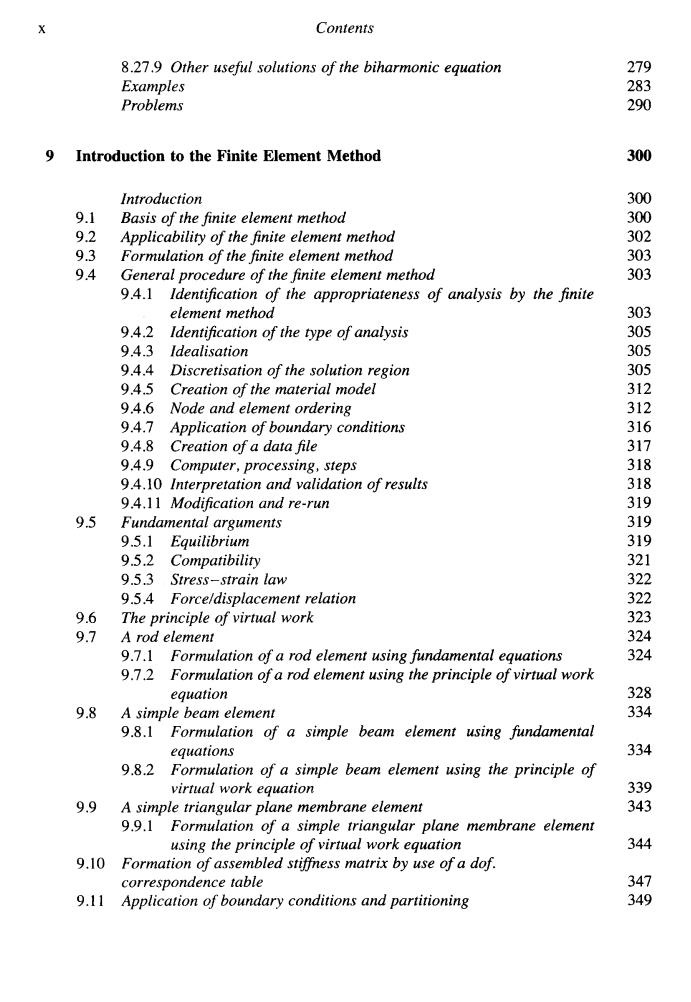正在加载图片...

Contents 8.27.9 Other useful solutions of the biharmonic equation 279 Examples 283 Problems 290 Introduction to the Finite Element Method 300 Introduction 300 9.1 Basis of the finite element method 300 9.2 Applicability of the finite element method 302 9.3 Formulation of the finite element method 303 9.4 General procedure of the finite element method 303 9.4.1 Identification of the appropriateness of analysis by the finite element method 303 9.4.2 Identification of the type of analysis 305 94.3 Idealisation 305 9.4.4 Discretisation of the solution region 305 9.4.5 Creation of the material model 312 9.4.6 Node and element ordering 312 9.4.7 Application of boundary conditions 316 9.4.8 Creation of a data file 317 9.4.9 Computer,processing,steps 318 9.4.10 Interpretation and validation of results 318 94.11 Modification and re-run 319 9.5 Fundamental arguments 319 9.5.】Equilibrium 319 9.5.2 Compatibility 321 9.5.3 Stress-strain law 322 9.5.4 Forceldisplacement relation 322 9.6 The principle of virtual work 323 9.7 A rod element 324 9.7.1 Formulation of a rod element using fundamental equations 324 9.7.2 Formulation of a rod element using the principle of virtual work equation 328 9.8 A simple beam element 334 9.8.1 Formulation of a simple beam element using fundamental equations 334 9.8.2 Formulation of a simple beam element using the principle of virtual work equation 339 9.9 A simple triangular plane membrane element 343 9.9.1 Formulation of a simple triangular plane membrane element using the principle of virtual work equation 344 9.10 Formation of assembled stiffness matrix by use of a dof. correspondence table 347 9.11 Application of boundary conditions and partitioning 349X Contents 8.27.9 Other useful solutions of the biharmonic equation Examples Problems 9 Introduction to the Finite Element Method 9.1 9.2 9.3 9.4 9.5 9.6 9.7 9.8 9.9 9.10 9.1 1 Introduction Basis of the finite element method Applicability of the finite element method Formulation of the Jinite element method General procedure of the Jinite element method 9.4.1 Identification of the appropriateness of analysis by the jinite element method 9.4.2 Identification of the type of analysis 9.4.3 Idealisation 9.4.4 Discretisation of the solution region 9.4.5 Creation of the material model 9.4.6 Node and element ordering 9.4.7 Application of boundary conditions 9.4.8 Creation of a data file 9.4.9 Computer, processing, steps 9.4.10 Interpretation and validation of results 9.4.1 1 Modification and re-run Fundamental arguments 9.5.1 Equilibrium 9.5.2 Compatibility 9.5.3 Stress-strain law 9.5.4 Forceldisplacement relation The principle of virtual work A rod element 9.7.1 Formulation of a rod element using fundamental equations 9.7.2 Formulation of a rod element using the principle of virtual work equation A simple beam element 9.8.1 Formulation of a simple beam element using fundamental equations 93.2 Formulation of a simple beam element using the principle of virtual work equation A simple triangular plane membrane element 9.9.1 Formulation of a simple triangular plane membrane element using the principle of virtual work equation Formation of assembled stcfiess matrix by use of a dof. correspondence table Amlieation of boundarv conditions and uartitioninn r, " 279 283 290 300 300 300 302 303 303 303 305 305 305 312 312 316 317 318 318 319 319 319 321 322 322 323 324 324 32% 334 3 34 339 343 344 347 349